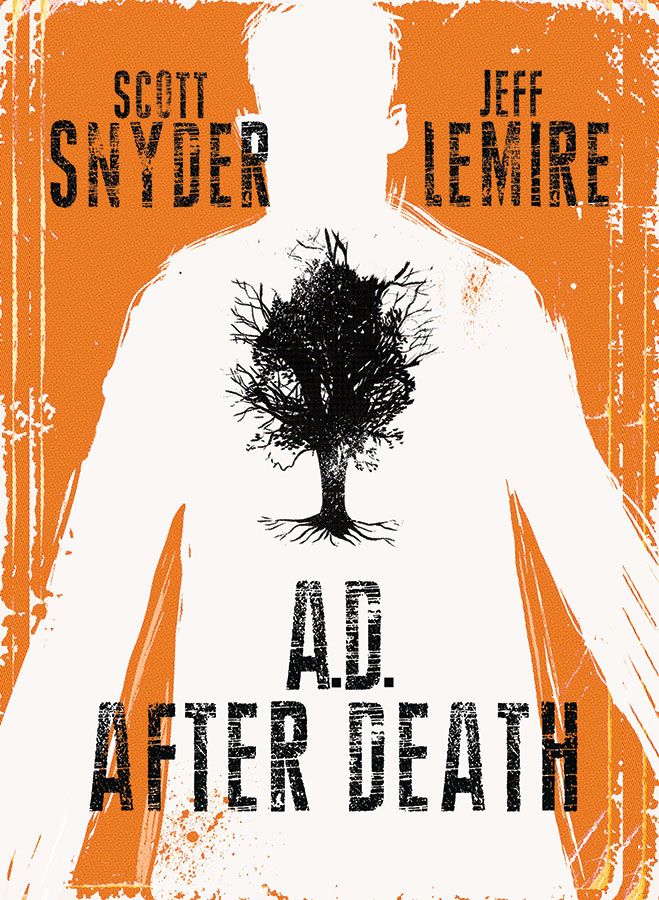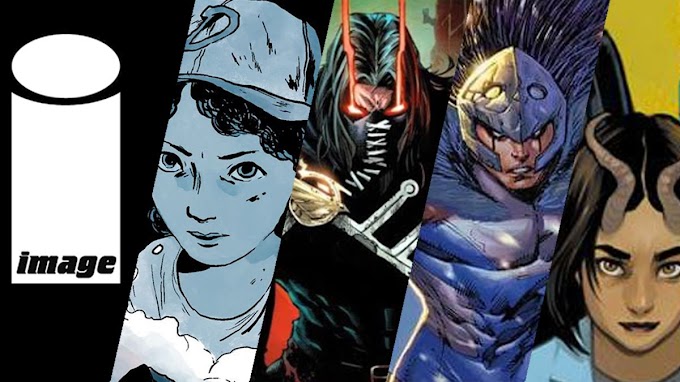
If you love horror,you've come to the right place! It's another entry in Panel Patter's Halloween Horror 2014! You can find all our eerie entries by following this Halloween Horror tag.
And Then Emily Was Gone (Issues 1-3)
Written by John Lees
Illustrated by Iain Laurie
Colors by Megan Wilson
Letters by Colin Bell
Published by ComixTribe
And Then Emily Was Gone is a genuinely scary, weird unsettling new comic that combines creepy monsters and old legends, and effectively creates a moody, lonely atmosphere that is well-suited to the story.
Fiona and her best friend Emily are teenagers living on the island of Merksey, one of the Orkney islands north of Scotland. They decided to leave the island after Emily claimed to have seen Bonnie Shaw, a bogeyman legend on the island. Fiona went to meet Emily that night at the ferry, but she never showed. Fiona didn't believe Emily just left without her, so Fiona left the island and sought the assistance of Greg Hellinger, a former police officer who left the service years ago because he began to see monsters everywhere. He sees them everywhere still, and hasn't gotten a decent night's sleep in five years. Fiona believed that Emily was taken by Bonnie Shaw, and despite his reluctance Hellinger decides to help her (mostly because since the moment he met Fiona, Hellinger hasn't seen a monster).
Over the course of the next few issues, Fiona and Hellinger investigate the missing Emily. They encounter various locals and ask about the legend of Bonnie Shaw, run into weird and frightening phenomena (and people), and get some leads on their investigation. Meanwhile, the storytelling scope is broadened as Emily's very unusual, troubled parents (and Fiona's father) are introduced, along with two other characters (Vincent and Louise) with a mysterious link to the events that are going on (and who further show the dark, twisted nature of the story). In the third issue, things come together in a way that broadens the mysteries and provides further hints as to how the characters are intertwined.
 This comic really creeped me out, which means that I think it did its job very effectively. Lees, Laurie and the rest of the creative team do some very effective work in creating a disturbing, depressing atmosphere where it feels like something terrible is lurking just around the corner. The team conveys the loneliness of Merksay as a setting, and the reader understands that this is a strange, disturbed place under the somewhat friendly veneer. They've also done some great work in introducing the main characters. We don't know much about Fiona but we sense her strong, determined nature, as well as both her love for and her below-the-surface resentment of Emily.
This comic really creeped me out, which means that I think it did its job very effectively. Lees, Laurie and the rest of the creative team do some very effective work in creating a disturbing, depressing atmosphere where it feels like something terrible is lurking just around the corner. The team conveys the loneliness of Merksay as a setting, and the reader understands that this is a strange, disturbed place under the somewhat friendly veneer. They've also done some great work in introducing the main characters. We don't know much about Fiona but we sense her strong, determined nature, as well as both her love for and her below-the-surface resentment of Emily. Hellinger is well characterized here as well. He's clearly a man doing everything he can not to completely crack up. He's spent so long in the world of monsters, and not knowing whether what he's seeing is real, that he's at the end of his rope, and he's hoping that somehow solving this case will bring him some amount of peace. Emily is a bit of a cipher, as her disappearance is the inciting action for the story but we don't really know much about her and don't see anything from her perspective. Hopefully as the story progresses we'll learn more about her.
 Much of the work of establishing this tone is accomplished very effectively through the art and design of the book. Laurie and Wilson do some extremely creepy work in the story. One choice which works well is to have dreams and flashbacks appear in different panel shapes than the "present" action of the story. Both use much more jagged or misshapen borders with a greater use of white space; this shows that what we're seeing is being presented through the distortion of memory, or has more of the appearance of isolated scenes. It also helps the reader distinguish between past and present, and the nightmare and reality (though both are pretty dark places). There are a few moments where these more jagged borders are used to depict current action, and they're both pretty horrific moments, so these jagged or nonexistent (in a few places) panel borders effectively depict moments where reality has become a nightmare and essentially broken out of the panels.
Much of the work of establishing this tone is accomplished very effectively through the art and design of the book. Laurie and Wilson do some extremely creepy work in the story. One choice which works well is to have dreams and flashbacks appear in different panel shapes than the "present" action of the story. Both use much more jagged or misshapen borders with a greater use of white space; this shows that what we're seeing is being presented through the distortion of memory, or has more of the appearance of isolated scenes. It also helps the reader distinguish between past and present, and the nightmare and reality (though both are pretty dark places). There are a few moments where these more jagged borders are used to depict current action, and they're both pretty horrific moments, so these jagged or nonexistent (in a few places) panel borders effectively depict moments where reality has become a nightmare and essentially broken out of the panels.
It is not at all surprising that both Frank Quitely and Nick Pitarra have both praised the work on this book, and it's also worth noting that Nick Pitarra has done a variant cover for one of the issues. Laurie has a style which is in some ways reminiscent of both artists, however this is very much his own style. Every character in the story has a sense of ugliness to them, to varying degrees. This is not a pretty world, these are not pretty characters. They're presented in an exaggerated, manner, as every flaw, every line, the shape of their noses and heads are bodies are somewhat magnified and distorted; the effect of this is that each character's appearance makes the reader uneasy.
 Beyond the human character design, there are real monsters in this story; whether they're really there or in people's heads or imaginations, they're genuinely unsettling, disgusting, scary creations. If I hallucinated the monsters that Hellinger saw, I wouldn't sleep either. The backgrounds and settings, while also exaggerated and distorted, really capture the narrative truth of the story. Hellinger's apartment feels like the apartment of a person who hasn't had a good night's sleep in years. The gloominess and loneliness of Merksay is effectively captured. The office that Vincent and Louise visit for their next "assignment" is clearly shown not just to be run-down, but to also be a grotesque, sinister place. The B&B where Hellinger and Fiona stay is a place where you can almost smell the mothballs and peeling paint.
Beyond the human character design, there are real monsters in this story; whether they're really there or in people's heads or imaginations, they're genuinely unsettling, disgusting, scary creations. If I hallucinated the monsters that Hellinger saw, I wouldn't sleep either. The backgrounds and settings, while also exaggerated and distorted, really capture the narrative truth of the story. Hellinger's apartment feels like the apartment of a person who hasn't had a good night's sleep in years. The gloominess and loneliness of Merksay is effectively captured. The office that Vincent and Louise visit for their next "assignment" is clearly shown not just to be run-down, but to also be a grotesque, sinister place. The B&B where Hellinger and Fiona stay is a place where you can almost smell the mothballs and peeling paint. It's solid, skillful work, in all aspects of storytelling. Wilson's coloring in the story is subtle and makes some non-obvious choices. It would've been easy to color this story in mostly dark colors and grays. But the color choices here are more varied and distinct. There is a strong presence of grays, but also browns, yellows and other earth tones that show that maybe this once was a prettier world, but now it's drab and worn out and in decline.
For a wonderful story you can give to your children so they'll never get a good night's sleep again, I'd recommend giving And Then Emily Was Gone a look.







